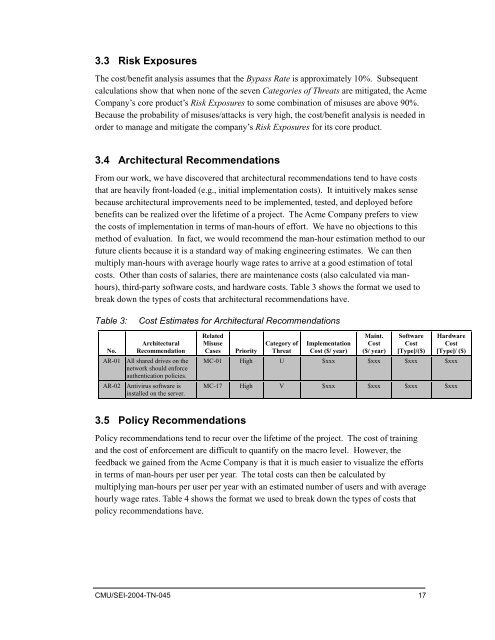SQUARE Project: Cost/Benefit Analysis Framework for Information ...
SQUARE Project: Cost/Benefit Analysis Framework for Information ...
SQUARE Project: Cost/Benefit Analysis Framework for Information ...
You also want an ePaper? Increase the reach of your titles
YUMPU automatically turns print PDFs into web optimized ePapers that Google loves.
3.3 Risk Exposures<br />
The cost/benefit analysis assumes that the Bypass Rate is approximately 10%. Subsequent<br />
calculations show that when none of the seven Categories of Threats are mitigated, the Acme<br />
Company’s core product’s Risk Exposures to some combination of misuses are above 90%.<br />
Because the probability of misuses/attacks is very high, the cost/benefit analysis is needed in<br />
order to manage and mitigate the company’s Risk Exposures <strong>for</strong> its core product.<br />
3.4 Architectural Recommendations<br />
From our work, we have discovered that architectural recommendations tend to have costs<br />
that are heavily front-loaded (e.g., initial implementation costs). It intuitively makes sense<br />
because architectural improvements need to be implemented, tested, and deployed be<strong>for</strong>e<br />
benefits can be realized over the lifetime of a project. The Acme Company prefers to view<br />
the costs of implementation in terms of man-hours of ef<strong>for</strong>t. We have no objections to this<br />
method of evaluation. In fact, we would recommend the man-hour estimation method to our<br />
future clients because it is a standard way of making engineering estimates. We can then<br />
multiply man-hours with average hourly wage rates to arrive at a good estimation of total<br />
costs. Other than costs of salaries, there are maintenance costs (also calculated via manhours),<br />
third-party software costs, and hardware costs. Table 3 shows the <strong>for</strong>mat we used to<br />
break down the types of costs that architectural recommendations have.<br />
Table 3:<br />
<strong>Cost</strong> Estimates <strong>for</strong> Architectural Recommendations<br />
Architectural<br />
No. Recommendation<br />
AR-01 All shared drives on the<br />
network should en<strong>for</strong>ce<br />
authentication policies.<br />
AR-02 Antivirus software is<br />
installed on the server.<br />
Related<br />
Misuse<br />
Cases<br />
Maint.<br />
<strong>Cost</strong><br />
($/ year)<br />
Software<br />
<strong>Cost</strong><br />
[Type]/($)<br />
Hardware<br />
<strong>Cost</strong><br />
[Type]/ ($)<br />
Category of Implementation<br />
Priority Threat <strong>Cost</strong> ($/ year)<br />
MC-01 High U $xxx $xxx $xxx $xxx<br />
MC-17 High V $xxx $xxx $xxx $xxx<br />
3.5 Policy Recommendations<br />
Policy recommendations tend to recur over the lifetime of the project. The cost of training<br />
and the cost of en<strong>for</strong>cement are difficult to quantify on the macro level. However, the<br />
feedback we gained from the Acme Company is that it is much easier to visualize the ef<strong>for</strong>ts<br />
in terms of man-hours per user per year. The total costs can then be calculated by<br />
multiplying man-hours per user per year with an estimated number of users and with average<br />
hourly wage rates. Table 4 shows the <strong>for</strong>mat we used to break down the types of costs that<br />
policy recommendations have.<br />
CMU/SEI-2004-TN-045 17
















